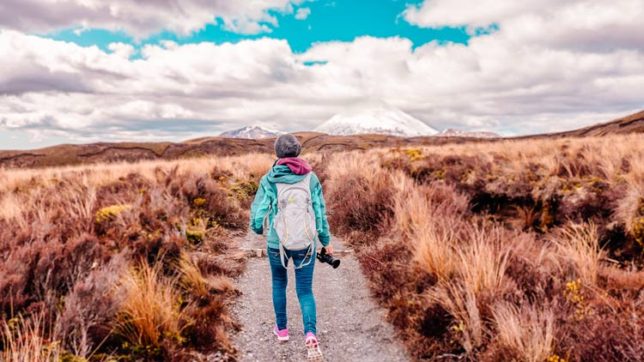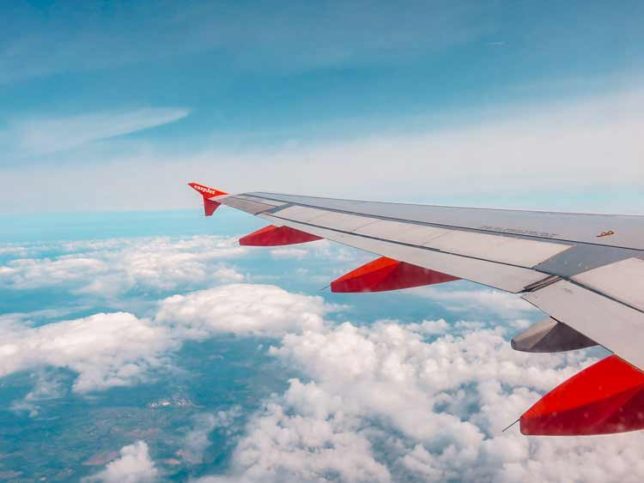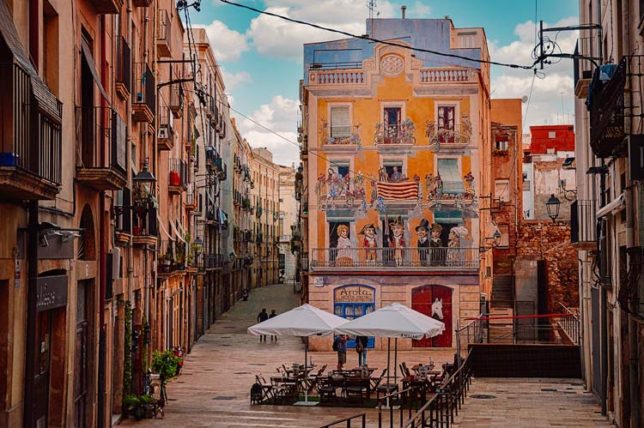The Ultimate Bologna Weekend Itinerary
Two days in Bologna might sound like a brief encounter, but that’s more than enough time to fall in love with its history, food, and its undeniable charm.
The city is a refreshing change from the throngs of tourists you see in neighboring Florence and Rome.
Endlessly long portico walkways, tall towers peeking out from behind the horizon, centuries-old architecture and those quintessential Italian windows in all shades of blue, green, and yellow… what a picture Bologna paints!
Also, did I mention the food?
I’m willing to start a petition to declare Bologna the food capital of Italy. You CAN’T go wrong with food here.

This two-day travel guide will take you through Bologna’s must-see landmarks, introduce you to the culinary profusion it offers, and point you to the best things to do in the city.
IS BOLOGNA WORTH VISITING?
*Nodding frantically*
Bologna often gets overshadowed by Italy’s more famous cities, and that’s why it’ll wow you EVEN more when you visit.
The city offers a rich blend of history, culture, and gastronomic delight, all wrapped in a welcoming, less tourist-heavy package.
The cool thing is that Bologna houses Europe’s oldest university and boasts a big student population; this gives it a youthful, high-energy vibe. At the same time, there’s a palpable air of unhurriedness (the trademark Italian one).
So, you get quite the mix of big city feels and laidback, delightful ease.
And if you’re someone who always orders spaghetti Bolognese on the menu when you see it, you HAVE to visit its birthplace, right?
Bologna is where ragu alla Bolognese originated. Not only this – tortellini, mortadella, and countless other beloved Italian foods owe their invention to the city.
You can eat your way through Bologna minus the overwhelming crowds.
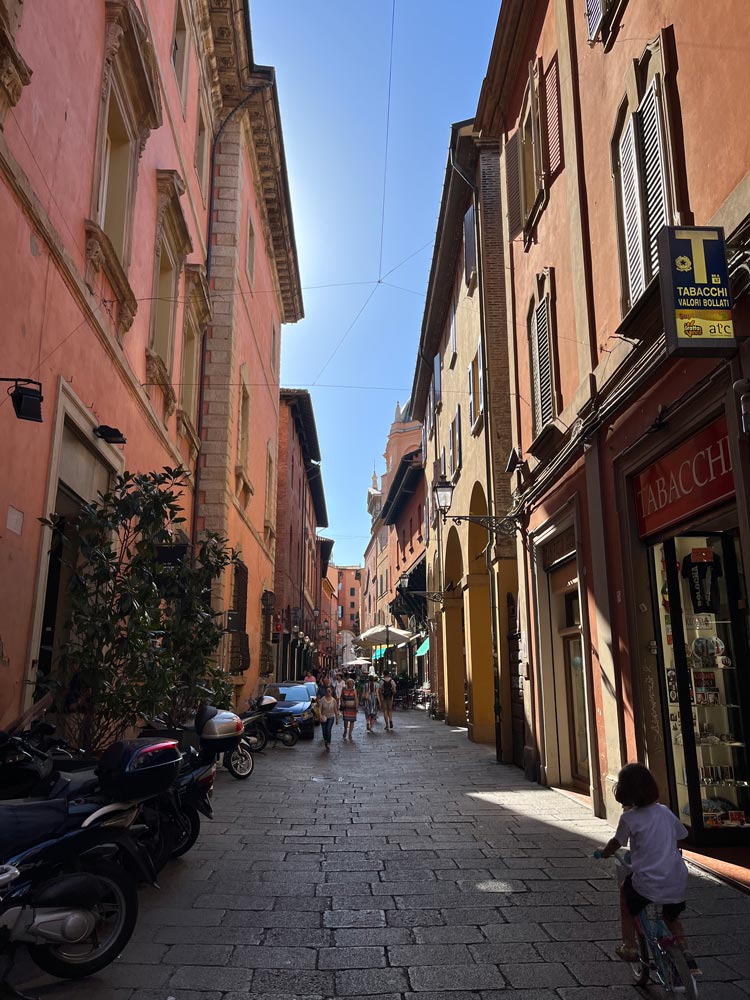
IS 2 DAYS ENOUGH FOR BOLOGNA?
Yes, two days is actually the sweet spot to experience the highlights of Bologna, although you can always spend more time here.
The city itself is relatively small. You can cover the center on foot, and many of the top sights like Piazza Maggiore, and Basilica di San Petronio are within walking distance of each other.
Day 2 can be dedicated to visiting the Sanctuary of Madonna di San Luca. And museum visits can be accommodated in the itinerary.
Of course Bologna has plenty more to offer, and if you had more time, you could delve deeper into the local food scene, take a cooking class, or explore some day trips from the city.
But even in just two days, you’ll get a full taste of Bologna’s best.
BOLOGNA 2 DAYS: ITINERARY & THINGS TO DO
Day 1 in Bologna
Piazza Maggiore
Start in Bologna’s historic city center, at its literal heart – Piazza Maggiore.
This square is like the center of everything in the city; and it has been one since 800 years. No matter where you are, you’ll always come back here. And there’s enough reason to!
Piazza Maggiore is a showcase of Bolognese history, with a rich tapestry of medieval, Renaissance and Baroque architecture. Some of the city’s biggest open-air events are held here (including free movie screenings in the summer). There’s always something going on.
Or there’s the buzz of conversation, tourists taking shade under the porticos in the rain, street musicians setting up the vibe, or folks just people-watching, relaxing and savoring la dolce vita as it comes 🙂
Basilica di San Petronio
From the outside, the Basilica has somewhat of an unfinished facade, but step inside and you’ll be blown away by its vastness and understated grandeur.
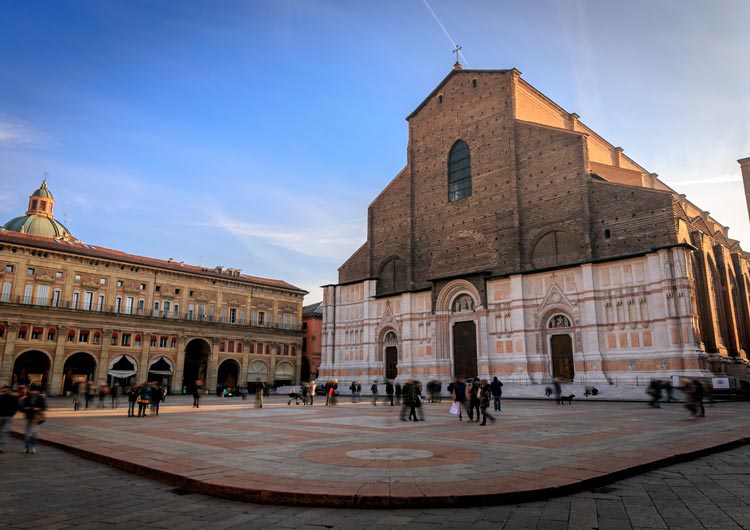
Basilica di San Petronio was built in 1390, with the ambition to be the largest church in the world, surpassing St. Peter’s Basilica in Rome. But political interference and power moves led to the funds being redirected elsewhere, effectively halting San Petronio’s expansion.
As a result, the basilica remains unfinished to this day. Its lower half boasts a gorgeous pink and white marble facade, while the upper half is exposed brick, giving it a kind of rugged look.
Inside, there’s a nave stretching 132 meters and vaulted ceilings soaring 45 meters high. Notice Giovanni Cassini’s 67-meter long sundial, the Meridian Line.
Also worth checking out is the controversial fresco by Giovanni di Modena, depicting “The Last Judgment”. The artwork famously includes an image of Muhammad being tormented in Hell, which has sparked protests and security concerns over the years.
Palazzo del Podesta and Torre dell’Arengo
Standing just across from the Basilica di San Petronio, you’ll find the Palazzo del Podesta – one of Bologna’s oldest government buildings. Perched over it is the Torre dell’Arengo (bell tower).
Built in the 13th century, Palazzo del Podesta was Bologna’s original seat of power, where the city’s rulers (the Podesta, or chief magistrates) administered justice. With its grand arcaded facade and medieval charm, it has long stood as a symbol of Bologna’s political and civic might.
The real magic, though, lies underneath its surface. Beneath the palace is a vaulted walkway called the Voltone del Podesta. If 2 people can stand at opposite corners of the arch, their voice travels across the curved ceiling crystal clear, even in a noisy crowd.
Legend has it that this was used by lepers confessing their sins to priests without needing to stand too close. Today, it’s a fun tourist (and local) things to do to test out “the hidden Bologna telephone”.
Piazza del Nettuno
Insider tip: If you want to skip the crowds a bit, take a detour down the side streets to explore Piazza del Nettuno. It sits right next to Piazza Maggoire and is smaller than its more prominent neighbor, but it houses just as much character and history.
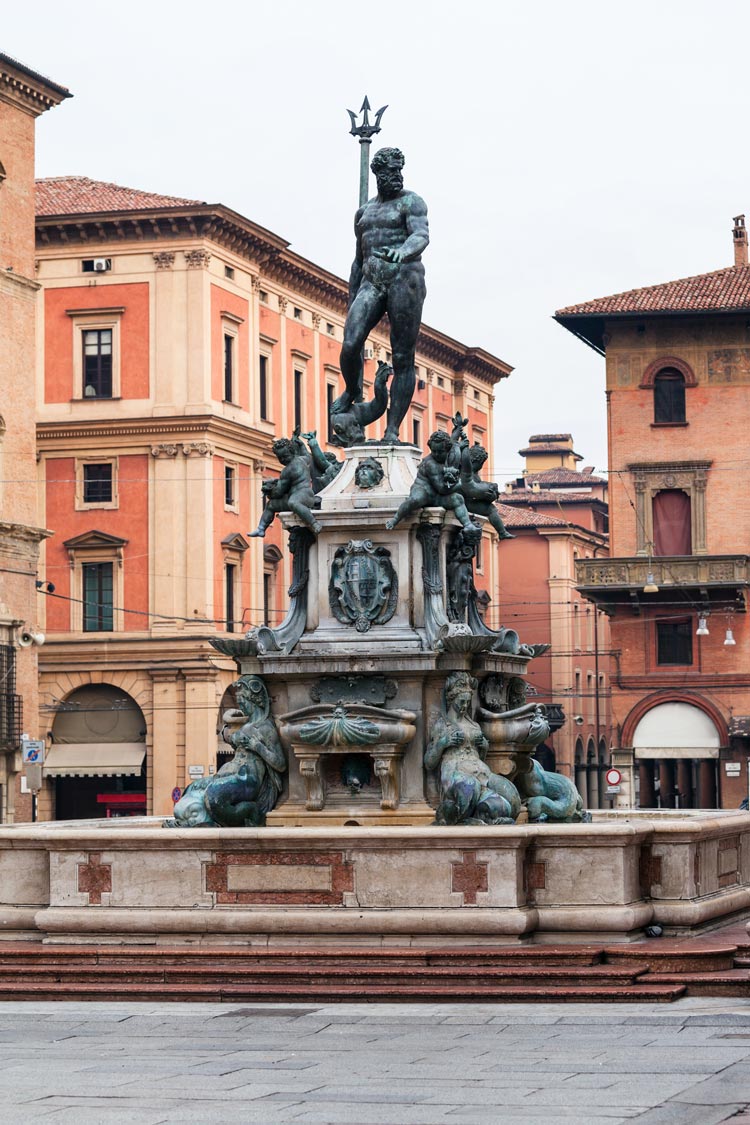
At the heart of the piazza stands the Fontana del Nettuno (Neptune Fountain), a hard-to-miss bronze and marble masterpiece that has become one of Bologna’s most iconic landmarks.
Commissioned in 1563 by Pope Pius IV and designed by the sculptor Giambologna, this massive statue of Neptune (the Roman God of the sea) was intended to symbolize papal power.
Piazza del Nettuno also has important landmarks like the Palazzo Re Enzo, and the stunning Salaborsa Library.
Get Lunch at Mercato di Mezzo
After all the sight seeing, head to Mercato di Mezzo, Bologna’s historic food market-turned-indoor food hall.
Located in the Quadrilatero district (which you must visit regardless of whether you eat here or not), this is a great place to sample the best of Bolognese cuisine minus the fuss. Otherwise, eating out in Italy can be a bit of a splurge.
Treat yourself to the holy grail of Bolognese food: tagliatelle al ragu. Not just any ragu, mind you, but the original Bolognese ragu that’s been perfected here for centuries. Wash it down with a glass of Lambrusco (practically a crime to be in Emilia-Romagna and not sip on its signature wine).
Because I’m vegetarian, ragu wasn’t an option for me. Here’s some local favorites that fellow vegetarians can try:
- Tigelle & Crescentine – traditional Bolognese flatbreads
- Tortelloni – a pasta with ricotta or spinach based filling. Often tossed in butter and sage. *drooling*
- Torta di riso (Bolognese rice cake) – because no meal is complete without dessert
Two Towers
After lunch, it’s time to climb Bologna’s Two Towers: Torre degli Asinelli and Torre Garisenda.
(Move over, Pisa. Bologna has its own version of the leaning tower – but make it twin 😉
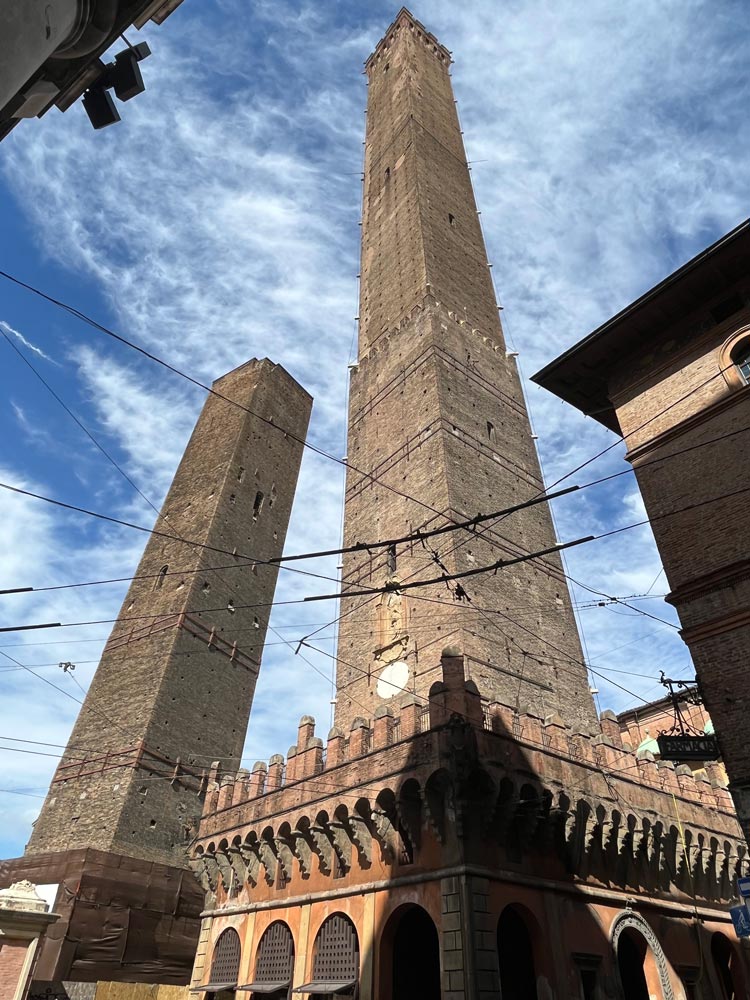
The Torre degli Asinelli and Torre Garisenda are Bologna’s most recognizable landmarks. These medieval skyscrapers are all that remain of the over 100 towers that dominated Bologna’s skyline in the 12th and 13th centuries.
At 97 meters, Torre degli Asinelli is the tallest leaning medieval tower in the world. And yes, you can climb it. Just 498 wooden steps … and some sweat and tears… will take you to the top, where you’ll be rewarded with one of the most fantastic panoramic views of Bologna.
Right next to Asinelli tower is the Torre Garisenda, standing at 48 meters.
Garisenda tower leans even more than the Tower of Pisa. The tilt became so extreme over the centuries that, in the 14th century, authorities had to shorten it to prevent it from collapsing.
Today, it leans at an impressive 4 degrees (Pisa’s leaning tower is at 3.97 degrees!). It really looks like it might tumble over at any second. But it’s stable… for now, at least!
Aperitivo & Dinner
If you’re in Italy, you CAN’T not embrace one of its most cherished traditions – the aperitivo.
As the sun dips behind Bologna’s terracotta rooftops, grab a seat at a local bar, order a spritz or Negroni, and ease into the evening.
Here’s how aperitivo works: You order a drink, and with it you’ll be served a selection of small bites. Think olives, mortadella, Parmigiano chunks, mini bruschetta, or sometimes even small plates of pasta.
During my visit I went to Marsalino and can absolutely recommend it. Also, Zerocinquantino in Quadrilatero does excellent cocktails.
For dinner, head to Trattoria Anna Maria for a cozy meal that feels like it’s been made in an Italian grandmother’s kitchen.
Honestly, though, you’ll find good food no matter where you go. It’s extremely hard to get poor quality food in Bologna, I’ll vouch for that.
End your day with a post-meal stroll along the Portico di San Luca or through the streets of the Quadrilatero district. If you find a gelato shop, stop and get some. Because you NEVER say no to gelato, especially in Italy!
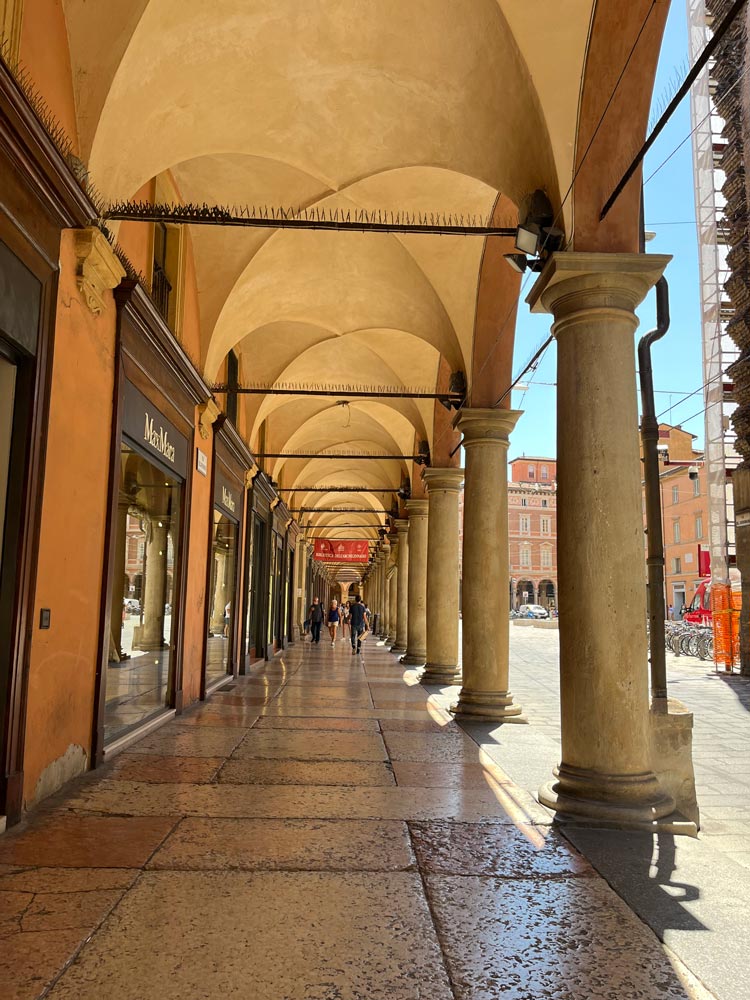
Day 2 in Bologna
Madonna di San Luca Sanctuary
Start your morning with a half-a-day trip to the Sanctuary of Madonna di San Luca.
Perched on top of a hill called Colle della Guardia just outside the city center, this basilica offers sweeping views of the surrounding countryside. It dates back to the 12th century, but its striking Baroque architecture, with its grand domes and ochre-colored walls, was completed in the 18th century.
The Sanctuary houses a venerated Byzantine icon of the Virgin Mary, which, per local legend, has been protecting Bologna from wars, plagues, and misfortune for centuries.
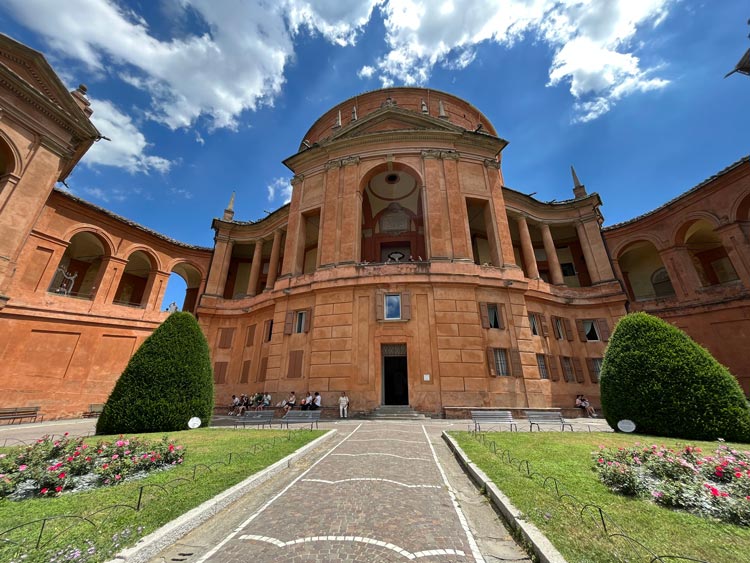
There are 3 ways to get to the Sanctuary:
- You can take a funicular ride up to the hilltop. It’s called San Luca Express, and it’s basically a tourist train service operating between Piazza Maggiore and the Sanctuary.
- Take a taxi from anywhere in the city, and it’ll take you right to the top up to the basilica.
- Do the portico walk starting from Porta Saragozza (my favorite way to get up there!)
The Iconic Portico Walk
One of the most unique aspects of San Luca is the 3.8-kilometer-long covered portico walkway leading up to it.
This ain’t no ordinary walkway – it’s the longest portico in the world, with 666 arches stretching from the city’s edge to the basilica at the top of Colle della Guardia.
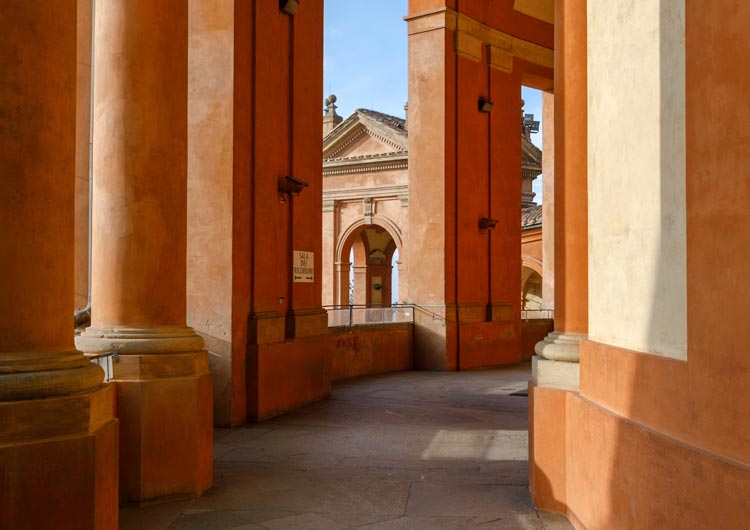
The walk up is a pilgrimage in itself, both physically and spiritually. It’s a 45-minute uphill climb, but the views along the way are stunning.
As you get closer to the sanctuary, you can gaze out over Bologna’s signature orange-red rooftops, rolling hills, and endless countryside which makes it completely worth it.
Lunch at Mercato delle Erbe
After a morning of culture, it’s time to head back to the city center.
If you’re a fan of local markets, another indoor food hall worth checking out is Mercato delle Erbe. It’s not exactly downtown but a short walk away from Piazza Maggoire.
You can snack on fresh local produce, cured meats, cheeses, and some fine drinks. It’s a no-frills place to grab a bite and catch the local pulse of the city.
MAMbo Museum
Next we explore some of Bologna’s finest museums.
MAMbo (the Museum of Modern Art) is such an interesting contrast to the city’s otherwise medievel architecture and feel. A must-visit for art lovers, it houses both contemporary works and exhibitions that showcase Italy’s thriving art scene.
MAMbo is located in a former bread bakery, and has permanent and rotating exhibitions. Some of the artwork includes pieces by Alberto Burri and Piero Manzoni.
Pinacoteca Nazionale
Instead of modern art, if you’re into the old masters, the Pinacoteca Nazionale di Bologna offers a treasure trove of Renaissance art to admire.
The museum has one of Italy’s most impressive collections of medieval and Renaissance paintings, with a strong focus on Bolognese and Emilian artists.
Walking through its halls feels really dramatic. You’re surrounded by ornate altarpieces, frescoes, and dramatic Baroque compositions.
Some of the prominent displays include the work of the Carraccis, Bologna’s most famous artistic family. There are also artworks by Guido Reni and Giotto.
The most famous painting in the museum, though, is the Ecstasy of Saint Cecilia by Raphael. It’s a stunning rendition.
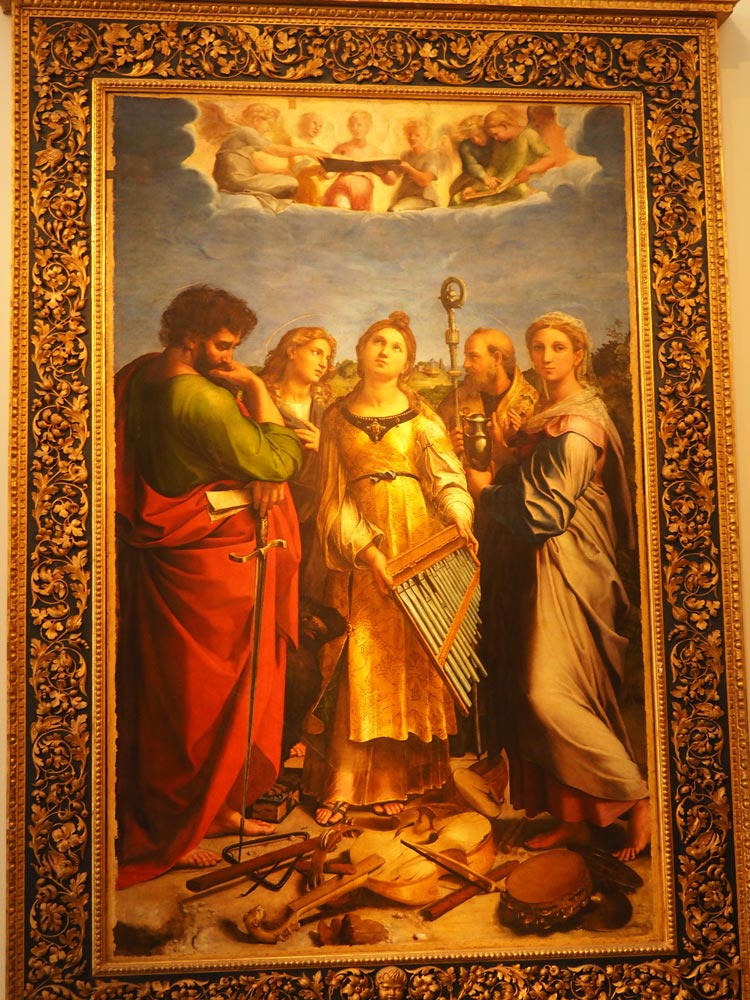
Bologna’s Hidden Canal
Did you know that Bologna once had an extensive canal system, much like Venice?
Over the centuries, most of it got covered. But you can still catch a glimpse of it at the Finestrella di Via Piella (literally meaning “Little Window in Via Piella”).
As you walk towards the Torresotti gate, under the portico you’ll see a small window. Open it and suddenly a Venetian-style canal appears!
It’s a little slice of history hidden in plain sight. Also, one of Bologna’s most unique photo spots.
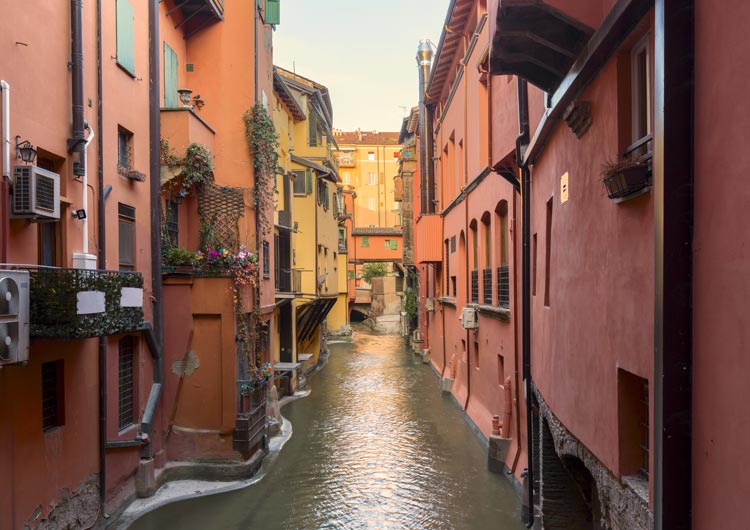
Dinner & Wrapping Up
For your final meal in Bologna, treat yourself to a Bolognese-style meal at a traditional trattoria. Indulge in a slow-cooked ragu or crescentine (fried bread served with cheeses). The traditional trattorias will offer a nice, cozy setting to round out your two-day Bologna itinerary.
After, stop at Cremeria Cavour or Gelateria Galliera 49 to get some gelato and call it a night.
WHERE TO STAY IN BOLOGNA
We stayed at the Casa di Aria in the city center. It’s a really nice B&B, complete with all amenities, a modern, artsy feel, and a great breakfast spread.
The staff is extremely welcoming, and the hotel is walking distance from most attractions.
Bologna also has some cool hostels which you could look up, too!
BOLOGNA TOURS & ACTIVITIES
I’m a big fan of group tours and activities. They help you see a city from the eyes of a local, sample regional favorites, meet fellow travelers, and partake in the kind of experiences you might not have discovered on your own.
Here are some activities in Bologna which I did during my visit, and can absolutely recommend:
- Olive Grove and Vineyard Tour with Wine Tasting: A short tour where we got to visit swathes of vineyards, learn about the estate’s oil and wine production, and try some brilliant wine and extra virgin olive oil right where it’s made.
- Pasta and Tiramisu Cooking Class: Make your tiramisu and eat it too! Catherina was the perfect host and I had such a ball at this cooking class!




